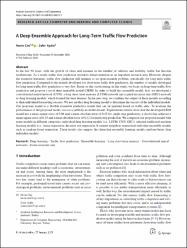| dc.contributor.author | Cini, Nevin | |
| dc.contributor.author | Aydin, Zafer | |
| dc.date.accessioned | 2024-03-04T12:53:16Z | |
| dc.date.available | 2024-03-04T12:53:16Z | |
| dc.date.issued | 2024 | en_US |
| dc.identifier.issn | 2193-567X | |
| dc.identifier.issn | 2191-4281 | |
| dc.identifier.other | WOS:001149226800001 | |
| dc.identifier.uri | https://doi.org/10.1007/s13369-023-08672-1 | |
| dc.identifier.uri | https://hdl.handle.net/20.500.12573/1979 | |
| dc.description.abstract | In the last 50 years, with the growth of cities and increase in the number of vehicles and mobility, traffic has become
troublesome. As a result, traffic flow prediction started to attract attention as an important research area. However, despite
the extensive literature, traffic flow prediction still remains as an open research problem, specifically for long-term traffic
flow prediction. Compared to the models developed for short-term traffic flow prediction, the number of models developed
for long-term traffic flow prediction is very few. Based on this shortcoming, in this study, we focus on long-term traffic flow
prediction and propose a novel deep ensemble model (DEM). In order to build this ensemble model, first, we developed a
convolutional neural network (CNN), a long short-term memory (LSTM) network and a gated recurrent unit (GRU) network
as deep learning models, which formed the base learners. In the next step, we combine the output of these models according
to their individual forecasting success. We use another deep learning model to determine the success of the individual models.
Our proposed model is a flexible ensemble prediction model that can be updated based on traffic data. To evaluate the
performance of the proposed model, we use a publicly available dataset. Experimental results show that the developed DEM
model has a mean square error of 0.06 and a mean absolute error of 0.15 for single-step prediction; it shows that achieves a
mean square error of 0.25 and a mean absolute error of 0.32 for multi-step prediction. We compared our proposed model with
many models in different categories; individual deep learning models (i.e., LSTM, CNN, GRU), selected traditional machine
learning models (i.e., linear regression, decision tree regression, k-nearest-neighbors regression) and other ensemble models
such as random-forest regression. These results also support the claim that ensemble learning models perform better than
individual models. | en_US |
| dc.language.iso | eng | en_US |
| dc.publisher | SPRINGER | en_US |
| dc.relation.isversionof | 10.1007/s13369-023-08672-1 | en_US |
| dc.rights | info:eu-repo/semantics/openAccess | en_US |
| dc.subject | Deep learning | en_US |
| dc.subject | Traffic flow prediction | en_US |
| dc.subject | Ensemble learning | en_US |
| dc.subject | Long short-term memory | en_US |
| dc.subject | Convolutional neural networks | en_US |
| dc.subject | Gated recurrent unit | en_US |
| dc.title | A Deep Ensemble Approach for Long-Term Traffic Flow Prediction | en_US |
| dc.type | article | en_US |
| dc.contributor.department | AGÜ, Mühendislik Fakültesi, Bilgisayar Mühendisliği Bölümü | en_US |
| dc.contributor.authorID | 0000-0001-5348-4043 | en_US |
| dc.contributor.authorID | 0000-0001-7686-6298 | en_US |
| dc.contributor.institutionauthor | Cini, Nevin | |
| dc.contributor.institutionauthor | Aydin, Zafer | |
| dc.identifier.startpage | 1 | en_US |
| dc.identifier.endpage | 16 | en_US |
| dc.relation.journal | ARABIAN JOURNAL FOR SCIENCE AND ENGINEERING | en_US |
| dc.relation.publicationcategory | Makale - Uluslararası Hakemli Dergi - Kurum Öğretim Elemanı | en_US |


















